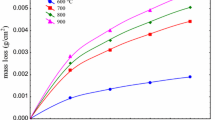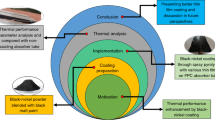Abstract
Steel tube boilers play predominant role in many process industries like nuclear power generation, petrochemical, desalination etc. The reliability of heat exchangers is an area which deserves close attention. Requirements for heat exchangers such as improved efficiency, stringent environmental needs, and cost effectiveness demand reliable materials specially for the heat exchanger tubing. Because, thermal efficiency reflects how well the boiler vessel transfers heat. To analyze the heat transfer performance of steel tube boiler, the proposed work implement the application of zinc oxide and graphene coating with an average rate of 8.06 µm and 10.9 µm, respectively. Since these coatings influences the wall thickness of steel tube boiler, the heat transfer characteristics is highly increased with enhanced heat dissipation through wall-surface. For experimental analysis, in boilers the heat transfer rate is measured using a heat transfer setup in which surface temperature and base temperature readings are recorded which in turn will be applied in the heat transfer mathematical equation to acquire the overall heat transfer rate. In addition, RSM, SEM evaluation is carried out to check whether roughness of a zinc oxide or graphene coating surface generates more area causing molecular interaction resulting in higher heat transfer rate.
























Similar content being viewed by others
Change history
24 February 2023
An Editorial Expression of Concern to this paper has been published: https://doi.org/10.1007/s41939-023-00140-5
References
Asotani T, Yamashita T, Tominaga H, Uesugi Y, Itaya Y, Mori S (2008) Prediction of ignition behavior in a tangentially fired pulverized coal boiler using CFD. Fuel 87(4–5):482–490
Baum M, Street P (1971) Predicting the combustion behaviour of coal particles. Combust SciTechnol 3(43):231
Brummel H-G. (2016) Thermal radiation of gas-solids-dispersions. In: V.D. Ingenieure, and V.-G.V. Chemieingenieurwesen (eds) VDI Heat Atlas, pp 989–98.
Chen T, Jun Zhang Y, Ran Liao M, Zong WW (2019) Coupled modeling of combustion and hydrodynamics for a coal-fired supercritical boiler. Fuel 240:49–56
Chernetskiy M, Dekterev A, Chernetskaya N, Hanjalic K (2016) Effects of reburning mechanically-activated micronized coal on reduction of NOx: computational study of a real-scale tangentially-fired boiler. Fuel 2018(214):215–229
Gronarz T, Habermehl M, Kneer R (2017) Modeling of particle radiative properties in coal combustion depending on burnout. Heat Mass Transf und Stoffuebertragung 53(4):1225–1235
Modlinski N (2010) Computational modeling of a utility boiler tangentially-fired furnace retrofitted with swirl burners. Fuel Process Technol 91(11):1601–1608
Pratheep VG, Priyanka EB, Prasad PH (2019) Characterization and analysis of natural fibre-rice husk with wood plastic composites. IOP Conf Ser Mater Sci Eng 561(1):012066
Sheng C, Moghtaderi B, Gupta R, Wall TF (2004) A computational fluid dynamics-based study of the combustion characteristics of coal blends in pulverized coal-fired furnace. Fuel 83(11–12):1543–1552
Shimogori M, Yoshizako H, Matsumura Y. (2012) Determination of coal ash emissivity using simplified equation for thermal design of coal-fired boilers. Fuel 95:241–6.
Wang H, Zhang C, Liu X (2019) Heat transfer calculation methods in three dimensional CFD model for pulverized coal-fired boilers. ApplThermEng 135:114633
Yin C, Yan J (2016) Oxy-fuel combustion of pulverized fuels: combustion fundamentals and modeling. Appl Energy 162:742–762
Acknowledgements
Not applicable.
Funding
Not applicable.
Author information
Authors and Affiliations
Contributions
All authors have read and approved the manuscript.
Corresponding authors
Ethics declarations
Conflict of interest
There is no conflict of interests among the authors regarding the publication of this article.
Additional information
Publisher's Note
Springer Nature remains neutral with regard to jurisdictional claims in published maps and institutional affiliations.
Rights and permissions
Springer Nature or its licensor (e.g. a society or other partner) holds exclusive rights to this article under a publishing agreement with the author(s) or other rightsholder(s); author self-archiving of the accepted manuscript version of this article is solely governed by the terms of such publishing agreement and applicable law.
About this article
Cite this article
Pratheep, V.G., Tamilarasi, T., Priyanka, E.B. et al. Study of heat transfer characteristics on steel tube boilers by the application of zinc oxide and graphene coatings. Multiscale and Multidiscip. Model. Exp. and Des. 5, 91–104 (2022). https://doi.org/10.1007/s41939-021-00090-w
Received:
Accepted:
Published:
Issue Date:
DOI: https://doi.org/10.1007/s41939-021-00090-w




